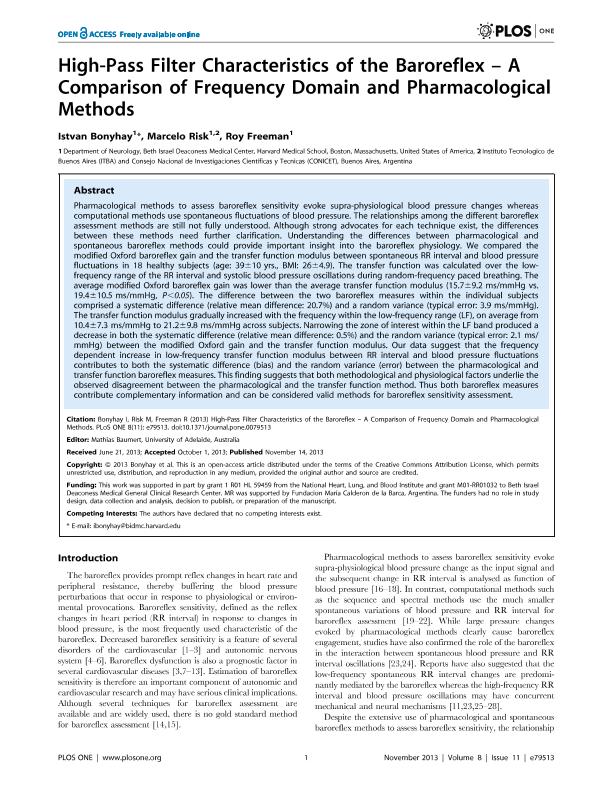Artículo
High-Pass Filter Characteristics of the Baroreflex - A Comparison of Frequency Domain and Pharmacological Methods
Fecha de publicación:
11/2013
Editorial:
Public Library Of Science
Revista:
Plos One
ISSN:
1932-6203
Idioma:
Inglés
Tipo de recurso:
Artículo publicado
Clasificación temática:
Resumen
Pharmacological methods to assess baroreflex sensitivity evoke supra-physiological blood pressure changes whereas computational methods use spontaneous fluctuations of blood pressure. The relationships among the different baroreflex assessment methods are still not fully understood. Although strong advocates for each technique exist, the differences between these methods need further clarification. Understanding the differences between pharmacological and spontaneous baroreflex methods could provide important insight into the baroreflex physiology. We compared the modified Oxford baroreflex gain and the transfer function modulus between spontaneous RR interval and blood pressure fluctuations in 18 healthy subjects (age: 39±10 yrs., BMI: 26±4.9). The transfer function was calculated over the low-frequency range of the RR interval and systolic blood pressure oscillations during random-frequency paced breathing. The average modified Oxford baroreflex gain was lower than the average transfer function modulus (15.7±9.2 ms/mmHg vs. 19.4±10.5 ms/mmHg, P<0.05). The difference between the two baroreflex measures within the individual subjects comprised a systematic difference (relative mean difference: 20.7%) and a random variance (typical error: 3.9 ms/mmHg). The transfer function modulus gradually increased with the frequency within the low-frequency range (LF), on average from 10.4±7.3 ms/mmHg to 21.2±9.8 ms/mmHg across subjects. Narrowing the zone of interest within the LF band produced a decrease in both the systematic difference (relative mean difference: 0.5%) and the random variance (typical error: 2.1 ms/mmHg) between the modified Oxford gain and the transfer function modulus. Our data suggest that the frequency dependent increase in low-frequency transfer function modulus between RR interval and blood pressure fluctuations contributes to both the systematic difference (bias) and the random variance (error) between the pharmacological and transfer function baroreflex measures. This finding suggests that both methodological and physiological factors underlie the observed disagreement between the pharmacological and the transfer function method. Thus both baroreflex measures contribute complementary information and can be considered valid methods for baroreflex sensitivity assessment.
Palabras clave:
Heart Rate Vriability
,
Baroreflex
,
Transfer Functions
,
Blood Pressure
Archivos asociados
Licencia
Identificadores
Colecciones
Articulos(SEDE CENTRAL)
Articulos de SEDE CENTRAL
Articulos de SEDE CENTRAL
Citación
Risk, Marcelo; Bonyhay, Istvan; Freeman, Roy; High-Pass Filter Characteristics of the Baroreflex - A Comparison of Frequency Domain and Pharmacological Methods; Public Library Of Science; Plos One; 8; e795; 11-2013; 1-12
Compartir
Altmétricas




